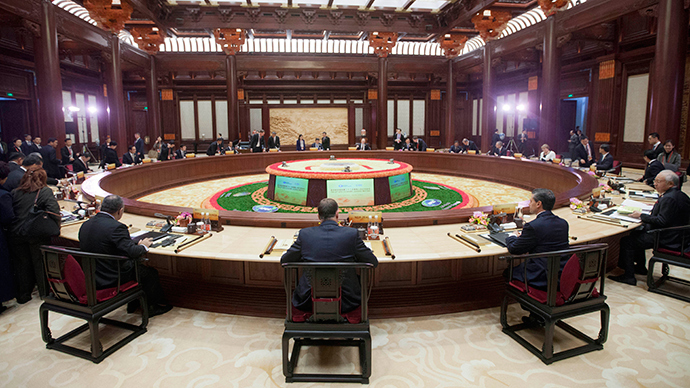Is Japan the missing link in China’s grand Asia-Pacific dream?

The reason behind China’s ‘frosty’ handshake with Japan is the significant role it plays in President Xi’s Asia-Pacific dream.
The handshake which Chinese President Xi Jinping and Japanese PM Shinzo Abe shared grabbed most of the headlines during the recently concluded Asia Pacific Economic Cooperation (APEC) Summit held in Beijing.
Relations between the two have been strained due to their fierce discord over control of the East China Sea islands called Diaoyu by China and Senkaku by Japan. Additionally Japan’s treatment of its colonial history enrages China - especially Abe’s visit to the Yasukuni shrine for the war dead, which the Chinese who were once under Japanese rule, see as a symbol of Japan’s military aggression and a denial of its imperial brutality.
So the decision for a meeting called for a lot of diplomatic balancing by Mr. Xi, who has been declining Mr. Abe’s requests since the 2012 fallout when China witnessed a country-wide anti-Japan protest after the Japanese government purchased the Diaoyu/Senkaku islands from private Japanese owners.
On one hand is the nationalistically charged Chinese public opinion and on the other the international observers who expected Beijing to act as an affable host.
However there are reasons why the Chinese President braved the speculation and shook hands with PM Abe. Prospects of better ties with Japan add enormously to Xi’s Asia-Pacific Dream - an economically and even politically integrated Asia-Pacific region with Beijing at its center.
At the heart of this dream is his “Asia for Asians” concept which refers to the capability of Asian community to resolve their issues themselves without needing any “external” intervention - believed to be a direct shot at the US’ “Asia Pivot.”
China has been building its case for an integrated economic zone through its massive infrastructure investment in the region and high profile initiatives like the Maritime Silk Road. Quite symbolically just ahead of the summit, President Xi announced an investment of $40 billion into the Silk Road fund that is committed to addressing the connectivity bottleneck in Asia.
Expected to top a GDP of $10 trillion by the end of this year, China sees itself as a natural leader of the Asian region – a notion which gets contradicted by the existence of the US pursued initiative - the 12 member Trans Pacific Partnership (TPP) – which incidentally excludes China but includes Japan as one of its main members in the region.
Beijing interprets TPP - an important part of Obama’s Asia Pivot –as a China containment tool. It seems to be particularly worried about the military alignment between Tokyo and Washington. No less a nationalistic leader than Mr. Xi, PM Abe also harbors the dream of becoming the number one power in Asia – a drive which has led him to brace up the country’s collective self-defense and deepen its military ties with the US.

Reports have it that the US and Japan are currently working on revising their defense plans apparently in anticipation of “new threats,” which experts feel is a tacit reference to China and its regional expansionism.
The pivot to Asia policy will reportedly have Washington install three additional ballistic missile defense (BMD) capable destroyers in Japanese ports. Tokyo also will be increasing its fleet of BMD destroyers by 2018, apart from additional submarines and helicopters.
Quite obviously, as of today Japan is one of the few countries that can challenge China militarily.
To counter this Beijing may use trade as a tacit pressure to get Japan by its side. At least that’s what it looks like going by the steps it took in dealing with its neighbors during APEC.
Already pursuing its Asia-Pacific free trade idea, called FTAAP - for which it secured a buy-in from APEC members to launch a two year strategic study, Beijing has also been pushing for a trilateral regional free trade agreement between China - South Korea - Japan.
During the summit China successfully concluded a free trade agreement (FTA) with South Korea with the promise of removing over 90 per cent of the tariffs on goods over the next two decades. Many feel this could be the first step towards getting Japan into the trilateral free trade agreement fold.
Japan is already alarmed at the development, especially the business community that wants better ties with China. As per reports Japan will lose annual exports worth $5.3 billion to South Korea after the China-South Korea FTA takes effect, while South Korea’s exports to China may rise by $27.7 billion.
The growing middle class in China is a massive market and source of growth for a sluggishly growing Japan. However, trade between the two has been declining for the last two years. According to the Japan External Trade Organization (JETRO) Japan’s total trade with China dropped 6.5 percent to $311.9 billion in 2013 from over $332 billion in 2012. Reports confirm if the political situation remains inflated trade could take a further hit.
The Japanese trade community is already propagating closer ties with China which Beijing may use to get Japan to eventually sign the trilateral FTA. Economically and militarily advanced, Tokyo’s membership of the trilateral FTA will create a considerable counter balance for the US’s TPP. In fact incidentally the TPP members had a not so successful meet on the sidelines of the APEC summit, due to a disagreement with Tokyo over trade barrier issues. Observers feel Beijing will not shy away from using this discord to its advantage.
There have been other significant developments around the time of the APEC summit which indirectly further Beijing’s Asia-Pacific dream. On one side was the second mega energy deal with Russia and talks of deepening ties with Australia which already has China accounting for 23 percent of its two-way trade. On the other is the expanding relation between Moscow and Tokyo with both committing to expand bilateral relations despite Japan being pressed to align closer with western allies over sanctions on Russia – its fourth largest supplier of natural gas and fifth-largest source of crude oil.
All these growing alliances actually put in place the entire string of China’s integrated Asia-Pacific aspiration with strong economic nations like South Korea and Australia on one side and an all-time ally Russia on the other. The only missing link perhaps is Japan. Whether Beijing can get this link to have its circle closed remains to be seen.
The statements, views and opinions expressed in this column are solely those of the author and do not necessarily represent those of RT.
The statements, views and opinions expressed in this column are solely those of the author and do not necessarily represent those of RT.













